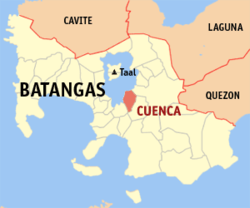Cuenca, Batangas
| Cuenca | ||
|---|---|---|
| Municipality | ||

Downtown Cuenca with Mount Maculot in the background
|
||
|
||
 Location within Batangas province |
||
| Location within the Philippines | ||
| Coordinates: 13°55′N 121°03′E / 13.92°N 121.05°ECoordinates: 13°55′N 121°03′E / 13.92°N 121.05°E | ||
| Country | Philippines | |
| Region | Calabarzon (Region IV-A) | |
| Province | Batangas | |
| District | 3rd District | |
| Founded | 1877 | |
| Barangays | 21 (see Barangays) | |
| Government | ||
| • Type | Sangguniang Bayan | |
| • Mayor | Celerino Endaya | |
| Area | ||
| • Total | 58.18 km2 (22.46 sq mi) | |
| Population (2015 census) | ||
| • Total | 32,783 | |
| • Density | 560/km2 (1,500/sq mi) | |
| • Voter (2016) | 21,655 | |
| Demonym(s) |
|
|
| Time zone | PST (UTC+8) | |
| ZIP code | 4222 | |
| IDD : area code | +63 (0)43 | |
| Income class | 4th class | |
| PSGC | 041009000 | |
Cuenca, officially the Municipality of Cuenca (Filipino: Bayan ng Cuenca), is a municipality in the province of Batangas in the Calabarzon (Region IV-A) of the Philippines. The population was 32,783 at the 2015 census. In the 2016 electoral roll, it had 21,655 registered voters.
Once a part of San Jose, it became an independent town under the name "Cuenca" in 1876. Its main tourist attraction is the 700-metre- (2,300 ft) high mountain, Mount Maculot.
The Patron of Cuenca is Saint Isidore the Laborer, the patron of farmers. A celebratory feast is held annually every May 15.
Cuenca is located at 13°55′N 121°03′E / 13.92°N 121.05°E.
According to the Philippine Statistics Authority, the municipality has a land area of 58.18 square kilometres (22.46 sq mi) constituting 1.86% of the 3,119.75-square-kilometre- (1,204.54 sq mi) total area of Batangas.
Cuenca is politically subdivided into 21 barangays. In 1954, Don Juan was constituted as a barrio from the sitios of Lungos ng Parang, Kulit, Lumampao, Pisa, Napapanayan and Lagundian.
In the 2015 census, Cuenca had a population of 32,783. The population density was 560 inhabitants per square kilometre (1,500/sq mi).
...
Wikipedia


